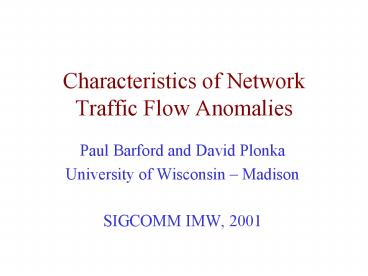Characteristics of Network Traffic Flow Anomalies - PowerPoint PPT Presentation
1 / 13
Title:
Characteristics of Network Traffic Flow Anomalies
Description:
Anomaly detection and identification is challenging ... Barford & Plonka. IMW 2001. 13. Acknowledgements. Somesh Jha. Jeff Kline. Amos Ron ... – PowerPoint PPT presentation
Number of Views:54
Avg rating:3.0/5.0
Title: Characteristics of Network Traffic Flow Anomalies
1
Characteristics of Network Traffic Flow Anomalies
- Paul Barford and David Plonka
- University of Wisconsin Madison
- SIGCOMM IMW, 2001
2
Motivation
- Traffic anomalies are a fact of life in computer
networks - Anomaly detection and identification is
challenging - Operators typically monitor by eye using SNMP or
IP flows - Simple thresholding is ineffective
- Some anomalies are obvious, other are not
- Characteristics of anomalous behavior in IP flows
have not been established - Do same types of anomalies have same
characteristics? - Can characteristics be effectively used in
detection systems?
3
Related Work
- Network traffic characterization
- Eg. Caceres89, Leland93, Paxson97, Zhang01
- Focus on typical behavior
- Fault and anomaly detection techniques
- Eg. Feather93, Brutlag00
- Focus on thresholds and time series models
- Eg. Paxson99
- Rule based tool for intrusion detection
- Eg. Moore01
- Backscatter technique can be used to identify DoS
attacks - No work which identifies anomaly characteristics
4
Our Approach to Data Gathering
- Consider anomalies in IP flow data
- Collected at UW border router - 5 minute
intervals - Archive of two years worth of data (packets,
bytes, flows) - Includes identification of anomalies
(after-the-fact analysis) - Group anomalies into three categories
- Network operation anomalies
- Steep drop offs in service followed by quick
return to normal behavior - Flash crowd anomalies
- Steep increase in service followed by slow return
to normal behavior - Network abuse anomalies
- Steep increase in flows in one direction followed
by quick return to normal behavior
5
IP Flows
- An IP Flow is defined as a unidirectional series
of packets between source/dest IP/port pair over
a period of time - Exported by Lightweight Flow Accounting Protocol
(LFAP) enabled routers (Ciscos NetFlow) - We use FlowScan Plonka00 to collect and process
Netflow data - Combines flow collection engine, database,
visulaization tool - Provides a near real-time visualization of
network traffic - Breaks down traffic into well known service or
application
SRC_IP/Port,DST_IP/Port,Pkts,Bytes,Start/End
Time,TCP Flags,IP Prot
6
Characteristics of Normal traffic
7
Our Approach to Analysis
- Analyze examples of each type of anomaly via
statistics, time series and wavelets (our initial
focus) - Wavelets provide a means for describing time
series data that considers both frequency and
scale - Particularly useful for characterizing data with
sharp spikes and discontinuities - More robust than Fourier analysis which only
shows what frequencies exist in a signal - Tricky to determine which wavelets provide best
resolution of signals in data - We use tools developed at UW Wavelet IDR center
- First step Identify which filters isolate
anomalies
8
First Look at Analysis of Normal Traffic
- Wavelets easily localize familiar daily/weekly
signals
9
First Look Analysis of Attacks
- DoS sharp increase in flows and/or packets in
one direction - Linear splines seem to be a good filter to
distinguish DoS attacks
10
Characteristics of Flash Crowds
- Sharp increase in packets/bytes/flows followed by
slow return to normal behavior eg. Linux releases - Leading edge not significantly different from DoS
signal so next step is to look within the spikes
11
Characteristics of Network Anomalies
- Typically a steep drop off in packets/bytes/flows
followed a short time later by restoration
12
Conclusion and Next Steps
- Project to characterize network traffic flow
anomalies - Based on flow data collected at UW border router
- Anomalies have been grouped into three categories
- Analysis approach statistical, time series,
wavelet - Initial results
- Good indications that we can isolate signals
- Future
- Continue analysis of anomaly data
- Analysis of data from other sites
- Application of results in (distributed) detection
systems
13
Acknowledgements
- Somesh Jha
- Jeff Kline
- Amos Ron































